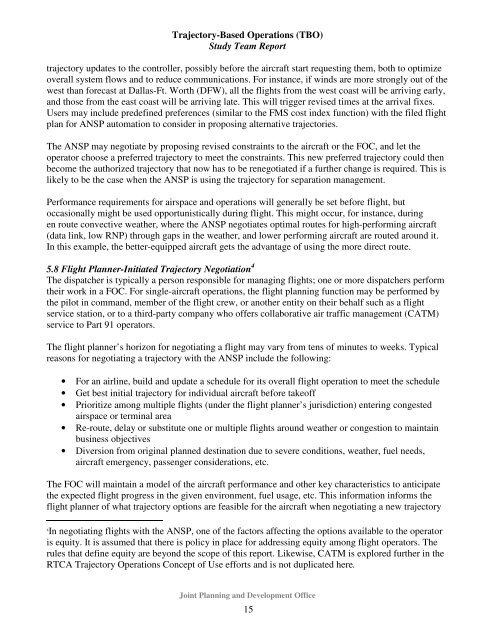Trajectory-Based Operations (TBO) - Joint Planning and ...
Trajectory-Based Operations (TBO) - Joint Planning and ...
Trajectory-Based Operations (TBO) - Joint Planning and ...
Create successful ePaper yourself
Turn your PDF publications into a flip-book with our unique Google optimized e-Paper software.
<strong>Trajectory</strong>-<strong>Based</strong> <strong>Operations</strong> (<strong>TBO</strong>)<br />
Study Team Report<br />
trajectory updates to the controller, possibly before the aircraft start requesting them, both to optimize<br />
overall system flows <strong>and</strong> to reduce communications. For instance, if winds are more strongly out of the<br />
west than forecast at Dallas-Ft. Worth (DFW), all the flights from the west coast will be arriving early,<br />
<strong>and</strong> those from the east coast will be arriving late. This will trigger revised times at the arrival fixes.<br />
Users may include predefined preferences (similar to the FMS cost index function) with the filed flight<br />
plan for ANSP automation to consider in proposing alternative trajectories.<br />
The ANSP may negotiate by proposing revised constraints to the aircraft or the FOC, <strong>and</strong> let the<br />
operator choose a preferred trajectory to meet the constraints. This new preferred trajectory could then<br />
become the authorized trajectory that now has to be renegotiated if a further change is required. This is<br />
likely to be the case when the ANSP is using the trajectory for separation management.<br />
Performance requirements for airspace <strong>and</strong> operations will generally be set before flight, but<br />
occasionally might be used opportunistically during flight. This might occur, for instance, during<br />
en route convective weather, where the ANSP negotiates optimal routes for high-performing aircraft<br />
(data link, low RNP) through gaps in the weather, <strong>and</strong> lower performing aircraft are routed around it.<br />
In this example, the better-equipped aircraft gets the advantage of using the more direct route.<br />
5.8 Flight Planner-Initiated <strong>Trajectory</strong> Negotiation 4<br />
The dispatcher is typically a person responsible for managing flights; one or more dispatchers perform<br />
their work in a FOC. For single-aircraft operations, the flight planning function may be performed by<br />
the pilot in comm<strong>and</strong>, member of the flight crew, or another entity on their behalf such as a flight<br />
service station, or to a third-party company who offers collaborative air traffic management (CATM)<br />
service to Part 91 operators.<br />
The flight planner’s horizon for negotiating a flight may vary from tens of minutes to weeks. Typical<br />
reasons for negotiating a trajectory with the ANSP include the following:<br />
• For an airline, build <strong>and</strong> update a schedule for its overall flight operation to meet the schedule<br />
• Get best initial trajectory for individual aircraft before takeoff<br />
• Prioritize among multiple flights (under the flight planner’s jurisdiction) entering congested<br />
airspace or terminal area<br />
• Re-route, delay or substitute one or multiple flights around weather or congestion to maintain<br />
business objectives<br />
• Diversion from original planned destination due to severe conditions, weather, fuel needs,<br />
aircraft emergency, passenger considerations, etc.<br />
The FOC will maintain a model of the aircraft performance <strong>and</strong> other key characteristics to anticipate<br />
the expected flight progress in the given environment, fuel usage, etc. This information informs the<br />
flight planner of what trajectory options are feasible for the aircraft when negotiating a new trajectory<br />
4<br />
In negotiating flights with the ANSP, one of the factors affecting the options available to the operator<br />
is equity. It is assumed that there is policy in place for addressing equity among flight operators. The<br />
rules that define equity are beyond the scope of this report. Likewise, CATM is explored further in the<br />
RTCA <strong>Trajectory</strong> <strong>Operations</strong> Concept of Use efforts <strong>and</strong> is not duplicated here.<br />
<strong>Joint</strong> <strong>Planning</strong> <strong>and</strong> Development Office<br />
15
















